Among the many hundreds of thousands of species in the world, Earth’s Extremely Threatened Flowers continue to hold a very special place in our hearts. Flowers rank among the most beautiful of Nature’s creations, yet many also remain extremely fragile, and now face numerous threats. Herein, we present to you a small collection of some of those flowers that currently find themselves in grave peril of extinction.
Rosy Periwinkle
Rosy Periwinkle Facts
- Heading our list of Earth’s Extremely Threatened Flowers, the Rosy Periwinkle forms a beautiful plant with incredible botanical usefulness.
- Given that it sits atop our list, it also holds the distinction of being quite rare and endangered.
- The plant also understandably became quite popular as an ornamental plant. Despite its delicate appearance, however, it remains an extremely hardy species.
- Sadly, it also has an extremely limited endemic range. Within that range, however, it now faces the threat of loss of habitat due to the practice of slash and
burn agriculture. - Fortunately, though, this little beauty proved to be highly adaptable and successfully became naturalized in numerous other parts of the world.
Rosy Periwinkle Physical Description
The beautiful and also highly versatile Rosy Periwinkle presents itself as either a herbaceous plant or an evergreen shrub.
It also grows either vertically or runs along the ground, and sometimes attains heights of as much as 3.1 ft (1 m).
In addition, the delicate-seeming flowers of this marvelous plant appear either white with a red center or a dark pink.
The leaves typically display a glossy green in color, with a thick leathery texture.
The fruit of the Rosy Periwinkle develops as an elongated follicle, occurring in pairs. Like many plants in its family, the sap of this plant has the consistency of a thick, milky white latex.
- Kingdom: Plantae
- Phylum: Angiosperms
- Class: Eudicots
- Order: Gentianales
- Family: Apocynaceae
- Genus: Catharanthus
- Species: C. roseus
Rosy Periwinkle Distribution, Habitat, and Ecology
The incredibly lovely Rosy Periwinkle grows endemically only on the island of Madagascar, itself extremely unique.
The delicate beauty of the plant also conceals a veritable cornucopia of chemical compounds. Some of the chemicals in the Rosy Periwinkle also have high toxicity, and ingestion of even a small amount can be fatal.
However, many of the other chemical compounds within the species prove invaluable in saving lives, making it highly useful.
Some of the diseases treated by a few of its compounds include a variety of cancers, diabetes, Hodgkin’s lymphoma, and even malaria.
Mount Ranier Lousewort
Mount Ranier Lousewort Facts
- Next, on our list of Earth’s Extremely Threatened Flowers comes the lovely but uniquely-named masterpiece, the Mount Ranier Lousewort.
- This delicate marvel of Nature bears the informative, if less than verbally appealing, common name for perfectly good reasons. The formal scientific name for this amazing Angiosperm, however, is the tongue-twisting term of Pedicularis rainierensis.
- The beautiful species received its technical name due to the efforts of the American researchers Francis Whittier Pennell and Fred Adelbert Warren. This team of dedicated researchers made the first formal recognition of it as a separate and distinct species.
- For the moment, the IUCN has no listing for the flowering plant. Any such listing would appear on the organizations’ published Red List of Threatened Species. That lack of listing occurs, in part, due to a lack of sufficient information about the plant.
- The government of the region in which it appears, however, does currently have a listing for its status. That governing body presently lists the Mount Ranier Lousewort as Sensitive. It earns that status due to its relative vulnerability to local factors.
- That’s because, in its native range, it’s especially vulnerable to the actions of man. It’s often trampled by campers and hikers, who favor its native area. It’s also vulnerable to grazing by elks and marmots. Many people also collect specimens, due to its appeal.
- This work of evolution nevertheless faces the same dangers as other species throughout the world. These consist of the dual threats of habitat loss and climate change. The nature of its range further augments its vulnerability to both of these factors.
Mount Ranier Lousewort Physical Description
The marvelous Mount Ranier Lousewort possesses several attributes that make it stand out in the minds of those who encounter it. Sheer physical size, however, isn’t among them. That’s due to the fact that, for all its loveliness, this Angiosperm remains small.
More precisely, individual specimens attain a maximum known height of only about 16 in (40.6 cm). Conversely, though, mature plants rarely attain heights measuring less than 6 in (15.25 cm). Most individuals, in fact, measure roughly in the middle of that range.
Each delicate plant typically produces several thin, mainly hairless stalks. Each of these in turn develops several stems, along which its pinnate leaves protrude. These average roughly 2 – 6 in (5 – 15 cm) in length. This foliage further averages about 1.2 in (3 cm) in width.
Each dazzling bloom of the Mount Ranier Lousewort, furthermore, produces its own wonders. These include a short, spike-like raceme atop the stem. These are further surrounded by 5 delicate petals. These features also generally manifest a bright yellow shade.
This work of Nature produces its fruit within relatively small, hairless capsules. These typically develop in a flattened and asymmetrical shape. Most commonly, these structures contain several seeds. Those usually manifest a unique, slightly wing-shaped design.
- Kingdom: Plantae
- Phylum: Angiosperms
- Class: Eudicots
- Order: Lamiales
- Family: Orobanchaceae
- Genus: Pedicularis
- Species: P. ranierensis
Mount Ranier Lousewort Distribution, Habitat, and Ecology
Quite sadly, the gorgeous Mount Ranier Lousewort appears to have evolved as endemic to a highly restricted zone of habitation. In fact, it appears in an extremely tiny section of the globe. That’s a portion of the region now known as the continent of North America.
Yet, even there this wonder of Nature only appears within a very narrow range of the continent. It further makes its home in the northwestern portion of the United States. There, it appears solely on and around the magnificent Mount Ranier, as the name hints at.
It therefore understandably principally inhabits an alpine environment. Smaller percentages of its population, however, make their home in nearby sub-alpine areas. Virtually all known specimens coincidentally appear within the boundaries of the Mount Ranier National Park.
Within that range, however, the plant appears to be moderately adaptible in its choice of specific ecosystems. That’s because across this limited range, it appears in several types of area. These include regions of rocky slopes, coniferous forests, and moist meadows.
These further most frequently themselves appear in close proximity to streams or lake basins. It also seems to require a very specific, and small, range of altitudes. Due to this, all known concentrations appear at altitudes between 4,800 – 6,800 ft (1,400 – 2,100 m).
Mount Ranier Lousewort, however, displays an impressive flexibility in terms of its soil requirements. That’s due to the fact that it performs equally well in different types of soil. These include regions of moist talus, spots of deep loam, and even areas of gravelly slopes.
Schweinitz Sunflower
Schweinitz Sunflower Facts
Third on our list of Earth’s Extremely Threatened Flowers, the Schweinitz Sunflower is an extremely rare variety of sunflower that also has an extremely limited habitat range.- Understandably, the U. S. Forest Service currently lists the plant as Endangered. As a result, however, the species has full protection by both local and federal law.
- Further, only 90 populations of the lovely sunflower currently exist, and these average fewer than 40 individual flowers each.
- This beautiful plant also bears the name of Lewis David von Schweinitz, who was a local clergyman and botanist (1780-1834).
- Finally, the greatest threats to its continued existence appear to be habitat loss and competition from invasive species.
Schweinitz Sunflower Physical Description
The gorgeous Schweinitz Sunflower ranks a member of the Aster family and a perennial species.
Its stems average an amazing 6.5 ft (2 m) in size, yet can occasionally attain heights of as much as 16 ft (4.8 m). Unlike most varieties of sunflower, however, the blooms remain relatively small in size.
Uniquely, the long stems actually display a deep purple color, which many consider extraordinary. The leaves grow thick and quite stiff and grow arranged in pairs, while their surface has a rough texture These also develop covered in numerous small spines.
The relatively small flowers show bright yellow in color. Each plant generally produces 3-6 of these flowers, which typically bloom for 2-3 weeks, beginning in August.
- Kingdom: Plantae
- Phylum: Angiosperms
- Class: Eudicots
- Order: Asterales
- Family: Asteraceae
- Genus: Helianthus
- Species: H. schweinitzii
Schweinitz Sunflower Distribution, Habitat, and Ecology
The Schweinitz Sunflower grows endemically in a highly restricted and specific habitat range. Its only known habitat consists of the Piedmont region of North Carolina and South Carolina, in the United States.
It is thought that this sunflower was once numerous in forests and grasslands. Today, the majority of its populations occur along roadsides.
In addition, the surprising plant may also be found in the few remaining regions of Carolina prairie.
Amazingly, it prefers to inhabit areas of poor soil, such as regions with high clay content and thrives in either full or partial sunlight.
Given that the majority of its remaining numbers exist along roadsides, highway maintenance is actually another leading threat to its existence.
Fairy Lantern
Fairy Lantern Facts
- Next, on our list of Earth’s Extremely Threatened Flowers comes the truly gorgeous Fairy Lantern
- Sadly, it also represents an extremely rare species of flowering plant that also lists as highly endangered.
- It also forms part of the lily family of flowers, and sometimes goes by the name White Globe Lily, and the Mt. Diablo Lily.
- This magnificent species also evolved as endemic to only a very small area, and, except for a few stragglers, occurs naturally on only one mountainside.
- On occasion, a few of the aforementioned stragglers appear in neighboring counties.
- However, these never seem to establish a permanent presence.
Fairy Lantern Physical Description
The rather ethereal looking Fairy Lantern classifies as a perennial herb. The plant also produces a rather long, branching stem, which generally attains a height of roughly 11.8 in (30 cm).
The lower leaves also typically grow longer than the stem itself. These average around 15.75 in (40 cm) in length, and remain throughout the life of the flower.
Generally, 2-3 other leaves also appear further up the stem. These commonly remain much shorter than the lower leaves and wither after the plant blooms.
The plant also may produce either a single bloom or a cluster of several, all of which may be either white, pink, or a pale yellow in color.
These blooms also typically develop spherical in shape, with the ends of the petals always touching each other and generally covered in fine hairs.
- Kingdom: Plantae
- Phylum: Angiosperms
- Class: Monocots
- Order: Lilliales
- Family: Liliaceae
- Genus: Calochortus
- Species: C. albus
Fairy Lantern Distribution, Habitat, and Ecology
Most notably, the Fairy Lantern inhabits an extremely limited range, consisting solely of the slopes of Mt. Diablo, in California, in the United States, in North America.
In addition, this stunning little beauty primarily inhabits areas of woods, shady grasslands, coastal bluffs, and rocky areas.
The Fairy Lantern is also utterly unique within its genus in one respect. These delicate blooms never open, but remain in their bud-shaped form throughout the endurance of the bloom.
There is also a small fruit, that is contained within a small, elongated pod, typically measuring roughly 1 in (2.5 cm) in length.
Black Bat Flower
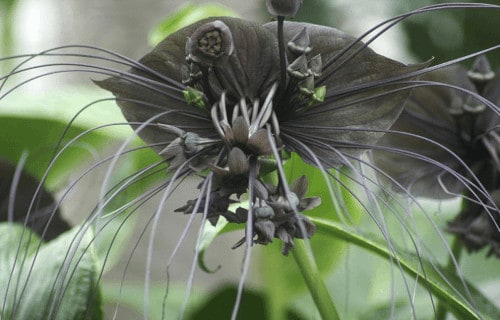
CCL: https://bit.ly/1ryPA8o
Black Bat Flower Facts
- The fifth species on our list of Earth’s Extremely Threatened Flowers is the amazing Black Bat Flower, also known as the Tacca chantrieri.
- First of all, the species, also known as the Tacca chantrieri, represents a truly unique variety of flowering plant. Believe it or not, it also forms a member of the yam family. However, though not considered toxic, it is not considered edible, either.
- This astounding form of life constitutes a most unusual species due to one specific reason. That’s the fact the fascinating flowers develop as black in color. This astounding characteristic ranks it as one of the few known flowers of which this holds true.
- Further, many people consider the impressive blooms it develops to have a somewhat bat-like shape. This therefore serves as the source of the common name. Though black remains the predominant color, the flower also occasionally develops in white or brown.
- Finally, while it does not presently hold an official listing with the IUCN, most experts currently consider the species to be endangered. While it faces other dangers, climate change represents its greatest threat, due to its need for a highly specific type of habitat.
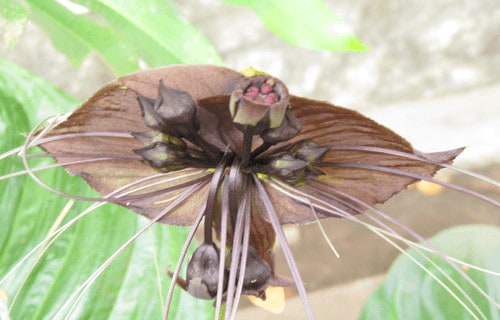
CCL: https://bit.ly/1p2b8Ke
Black Bat Flower Physical Description
Firstly, regardless of its unusual appearance, the awesome Black Bat Flower typically does not stand out to the eye when not blooming. That holds true due to the fact that it remains an average-sized plant. This surprising beauty attains a height of roughly 36 in (91 cm).
The amazing species also often develops numerous delicate-seeming tendrils that spread out from it. These features sometimes reach as much as 28 in (71 cm) in length. These give the plant a fascinating addition to its already distinctive look.
However, the most impressive part of the plant remains its unique bloom. This incredible flower often reaches a width of as much as 12 in (30 cm). Meanwhile, the modified leaves reach lengths of as much as 28 in (71 cm) in length.
Furthermore, the wide bloom consists of 2 large dark brackets. Not only that, but the long modified leaves fork at the ends. The dark brackets look like wings, and the leaves resemble the whiskers of a bat, hence the name.
Finally, the other leaves of the plant develop a marvelous bright green color. These same leaves also have a very smooth texture. In addition, the species produces an underground bulb used to store nutrients for a future need.
- Kingdom: Plantae
- Phylum: Angiosperms
- Class: Monocots
- Order: Dioscoreales
- Family: Dioscoreaceae
- Genus: Tacca
- Species: T. chantrieri
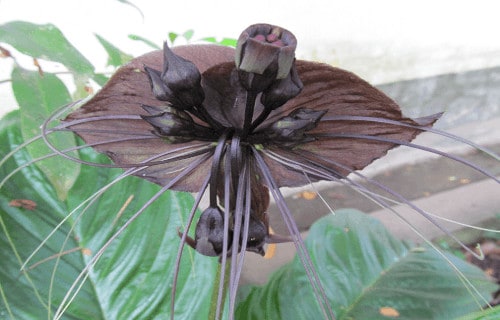
CCL: https://bit.ly/1p2b8Ke
Black Bat Flower Distribution, Habitat, and Ecology
It bears mentioning that the remarkable Black Bat Flower developed as endemic to a comparatively wide range. This includes specific regions of Australia, Africa, and Southeast Asia, including Thailand and parts of China.
Sadly, however, all 10 known varieties of this plant have become extremely rare in the wild. Furthermore, efforts to cultivate the plant rarely succeed. Although researchers continue to make the attempt, the reason for this failure eludes them.
But this unique flower requires very specific habitat types to flourish. Its primary natural habitat consists of areas of tropical jungle. This astounding perennial also requires high levels of humidity, shade, and well-drained soil in order to truly thrive.
In conclusion, to add to its impressiveness, the various varieties also bloom at different times. These times range from late Spring to early Fall. The genus blooms repeatedly, however, often as much as 8 times in a single season.
Blue Chilean Crocus
Blue Chilean Crocus Facts
- Listing as the sixth species on our list of Earth’s Extremely Threatened Flowers is the breathtaking Blue Chilean Crocus.
- Interestingly, despite the rather decptive name, the quite beautiful flower isn’t actually a crocus at all.
- Botanists actually classify this remarkable species as a member of a rather different family of flowering plants.
- Yet none can deny the delicate beauty of its blooms, regardless of its classification. Sadly, however, this same beauty consequently contributed to its near extinction in the wild, due to extensive over collecting.
- Partially due to this over collecting, the plant was believed extinct in the wild, until its rediscovery in 2001. Overgrazing and general habitat loss also played a role in its near demise in the wild. Yet, only a few apparently remain in the wild.
- While naturally occurring individuals near extinction, the species abounds in cultivation around the world. That’s because this beautiful plant has become very popular in numerous countries for landscaping and greenhouses.
Blue Chilean Crocus Physical Description
While not actually a crocus, the stunning Blue Chilean Crocus remains classified as a flowering perennial.
In addition, this small plant produces stems that average 4 in (10 cm) in height. Each of these develops 1-3 leaves that grow relatively long and elongated. These average 4 in (10 cm) in length, and 0.4 in (1 cm) in width, and display a bright green color.
Yet the flowers themselves rank as the most noteworthy feature of the species. These grow in a trumpet shape and may be either pale blue, deep blue, or even purple.
In the meantime, the fruit appears as a tiny, rounded capsule, and contains only a few, very small seeds. In addition, these often fall on rock and never germinate.
- Kingdom: Plantae
- Phylum: Angiosperms
- Class: Monocots
- Order: Asparagales
- Family: Tecophilaeaceae
- Genus: Tecophileae
- Species: T. cyanocrocus
Blue Chilean Crocus Distribution, Habitat, and Ecology
Firstly, the Blue Chilean Crocus only grows only in the country of Chile, in South America. And even there it currently now exists only in a few scattered locations.
This rare species only endemically inhabits a range restricted to altitudes ranging between 6,600 and 9,800 ft ( 2,000-3,000 m). Consequently, this range comprises extremely stony slopes in the Andes Mountains.
In its native habitat range, it blooms between October and November. However, natural propagation remains sparse, due to the nature of the environment and the tiny seed count per plant.
Yet, in cultivation, horticulturists accomplish this rather easily via the corms the plant produces. In its native range, its primary threats include habitat loss and climate change.
In conclusion, blooming typically requires about 5 years of growth.
Ghost Orchid
Ghost Orchid Facts
- Next on our list of Earth’s Extremely Threatened Flowers is the stunning as well as fascinating species known as the Ghost Orchid.
- The gorgeous plant most often known by the common name across much of its range, and represents a truly magnificent species of flora. The fabulous botanical beauty also goes by a few other common names in parts of its native range, however.
- A few of these alternate terms include the white frog orchid and the palm polly. This awesome flowering plant nevertheless also bears another, less memorable appellation. That’s the cumbersome scientific name of Dendrophylax lindenii.
- The Belgian plant collector Jean Jules Linden became the first person to officially recognize the species. The fortuitous discovery of this lovely plant occurred in the year 1844. In doing so, he gave the world a great gift of beauty.
- To the amazement of some, this plant holds a surprise. It bears a close relationship to species native to lands bordering the African and Indian Oceans. This occurs because the members of its genus all evolved during the time of Gondwana.
- Quite sadly, the truly stunning plant called the Ghost Orchid now finds itself in grave peril. This lamentable situation actually occurs due to not merely one problem, but a combination of multiple factors. These include its small range and habitat loss.
- It now also faces other great dangers to its continued existence. Perhaps the greatest of these, though, remains the threat of ongoing climate change. Presently, the IUCN lists it as Endangered on its Red List of Threatened Species.
Ghost Orchid Physical Description
The truly fantastic Ghost Orchid represents one of the orchid varieties that grows as what’s technically known as an epiphyte. That’s because it grows on the surface of another organism and receives its nourishment directly from the air and water.
Within its native habitat, however, this surface most commonly includes the limbs and trunks of trees. The remarkably adapted Angiosperm further displays a relatively strong preference for pop ash and pond-apple trees, though. The reason for this remains unknow.
The visually and physically distinctive variety of orchid typically also develops as a leafless vine. It also remains best known for the gorgeous blooms it produces. The marvelous Ghost Orchid further generally produces between 1 – 10 of these.
Not content to stop there, its blossoms also tend to open only one at at time, prolonging our enjoyment of its appeal. The flowers display a brilliant white color, and average 2.75 – 3.5 in (7 – 9 cm) in length. The same blooms also average 1.2 – 1.6 in (3 – 4 cm) in width.
- Kingdom: Plantae
- Phylum: Tracheophyte
- Class: Monocots
- Order: Asparagales
- Family: Orchidaceae
- Genus: Dendrophylax
- Species: D. lindenii
Ghost Orchid Distribution, Habitat, and Ecology
Quite unfortunately, the magnificent Ghost Orchid evolved to a natural range that poses it numerous problems. That’s because it appears in a portion of the globe that’s both extremely limited and restricted. These zones of habitation are also highly isolated.
In point of fact, the beautiful and delicate Angiosperm occurs in the wild in only two small portions of the world. To the amazement of some, these isolated locations include the island of Cuba, and the state of Florida, in the United States, in North America.
Its own nature tends to make it difficult for the beautiful plant to prosper, however. Regrettably, those same traits also make it even more complicated for it to spread in any numbers. That’s because the species of flora only appears naturally in very specific areas.
These extremely selective areas comprise regions consisting primarily of damp, swampy forests. But wait, there’s more yet to come. The fabulous, but highly selective plant also requires the presence of specific tree species in sufficient abundance.
The breathtaking Ghost Orchid also holds yet another distinction. That holds true due to the fact that its physical nature remains extremely uncommon among Monocots. Its leaves and stem have been reduced to almost non-existence.
As a result, the great majority of its mass now holds a most bizarre-seeming appearance. In point of fact, most of its form now consists of its many branching, hair-like roots. Finally, it’s also pollinated almost exclusively by a variety of moths, further distinguishing it.
Earth’s Extremely Threatened Flowers
We sincerely hope that you have enjoyed this article on Earth’s Extremely Threatened Flowers. Of course, many hundreds…if not thousands, of species of flowers now find themselves facing the possibility of extinction, along with numerous other plants, animals, and insects. Between Global Warming and human overpopulation, along with other factors, the other forms of life that we share this world with face a dire situation. It remains up to us to do all we can to prevent their demise.
Check out our other articles on Wonderful Wild Cats of the World, 5 Rare Mind-Blowing Cloud Types, 10 Extraordinary Reptiles

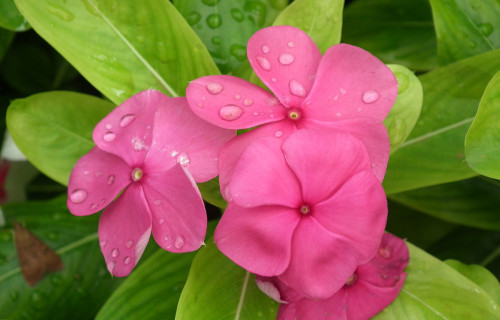
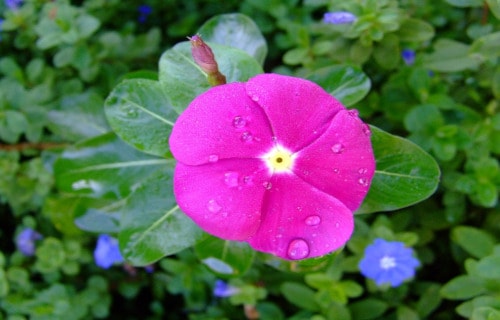
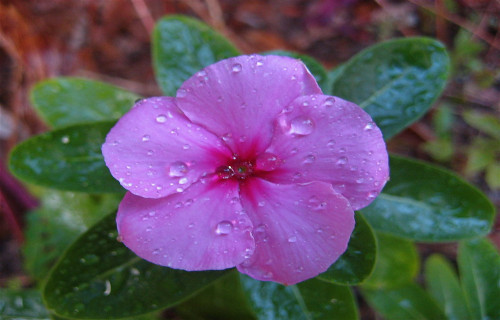
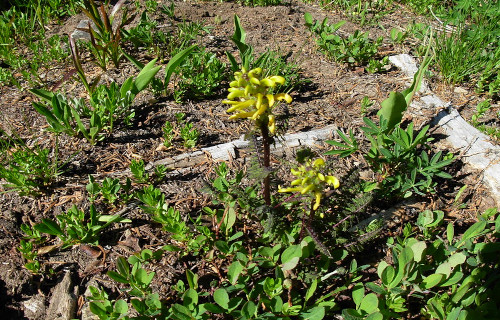
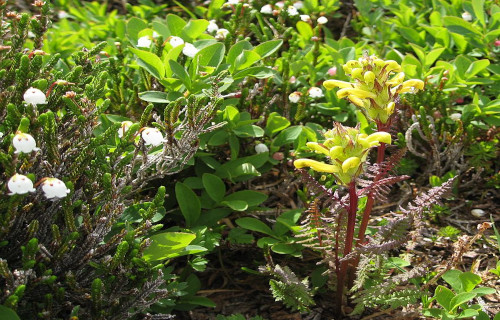
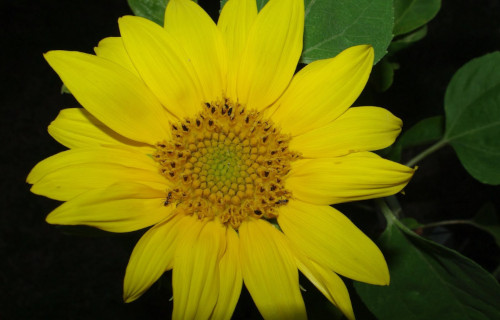
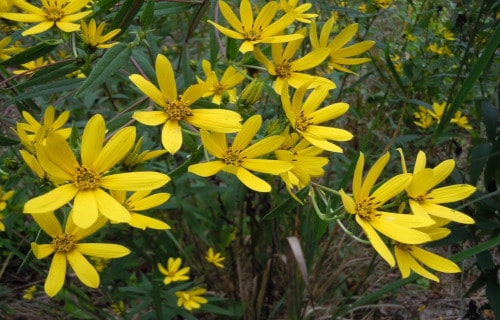
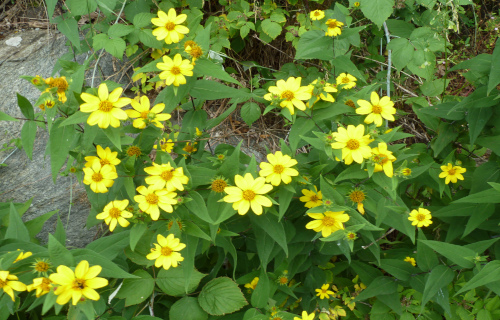
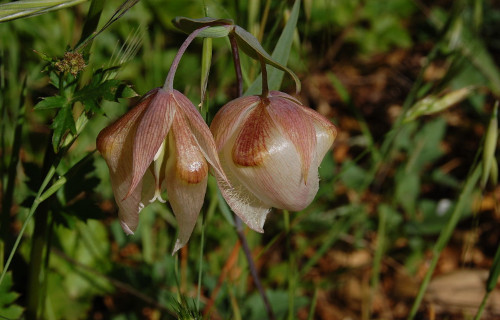
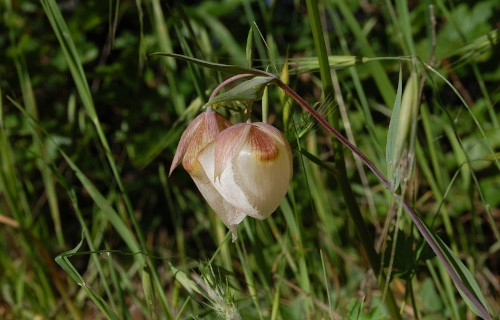
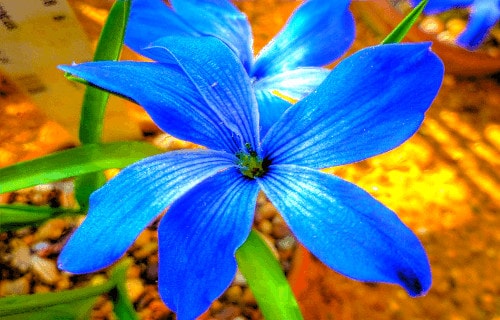
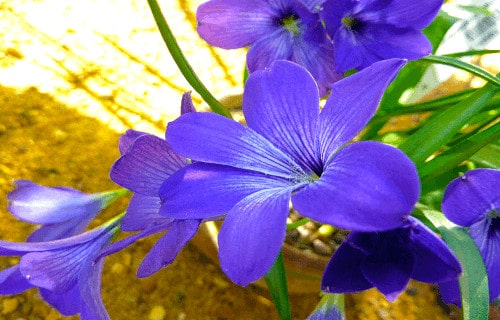

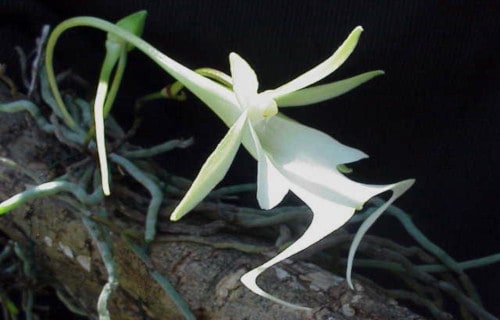
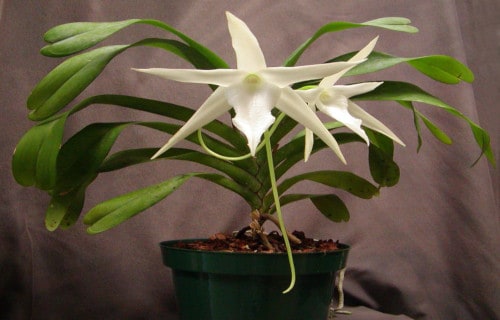
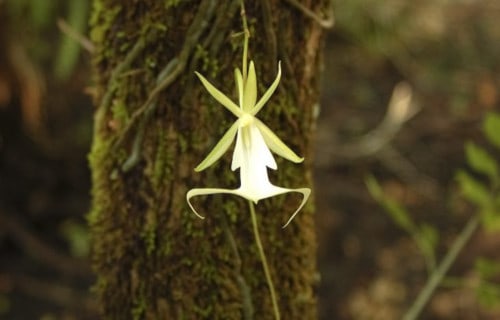









Leave a Reply